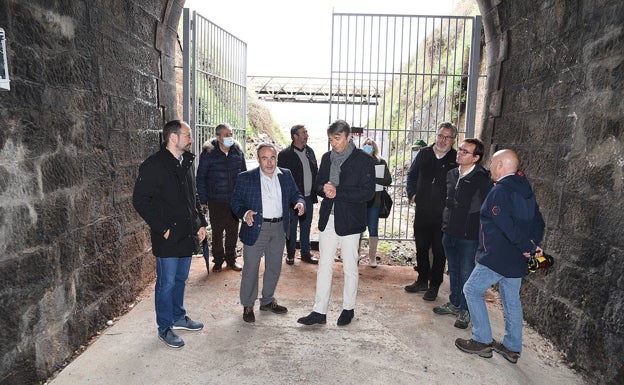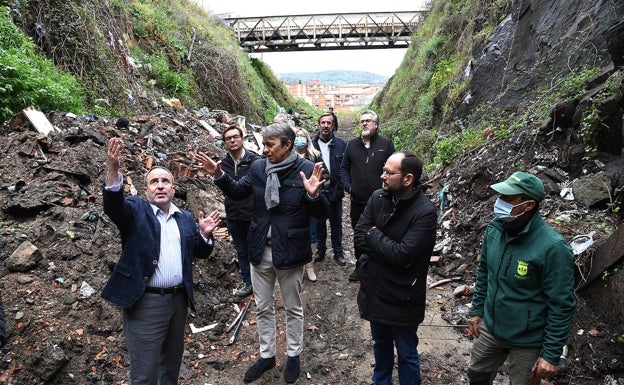North mouth of the San Lázaro tunnel, 180 meters long. The other is the one behind the Colegio de San Miguel. /
The City Council wants to build a footbridge over the N-630 in the north of the city, to prevent hikers and cyclists from crossing the road as is the case every weekend
This summer it will be possible to go by bike along the greenway from Plasencia to beyond Béjar, which will make this 65-kilometre section of the Ruta de la Plata one of the longest in Spain, according to what was announced this Friday by those responsible for State and the Junta de Extremadura during a visit to the San Lázaro tunnel works, which will be the official access from the city to this infrastructure. Official because there are already other unofficial ones, in theory not allowed but in practice used by more and more citizens for weeks, despite their insecurity.
One of them is through a path near the neighborhood of San Lázaro, which runs through private land and includes a steep embankment. The other, without a doubt the most popular, is through the old road to Salamanca, taking it on a curve located near the pavilion of the municipal sports city, about a hundred meters below the intersection of the N-630. There you take the old road, the beginning of a regular recreation area that ends when you run into the N-630, which usually has a lot of traffic. After going down this national road for about a hundred meters walking along the hard shoulder or pedaling, and crossing it, you reach the Valcorchero public mountain. Once there, a walk of about fifty meters down the field is enough to reach the new path for walkers and cyclists. Despite being closed with fences because it is under construction, the truth is that this point of the old route of the Ruta de la Plata train welcomes cyclists, walkers and even children and adults climbing every weekend in a section that runs between high vertical walls slate.
The solution handled by the City Council to avoid the risk of crossing the N-630 on foot is to build a footbridge over this national road. In fact, the Consistory hoped to finance it with the money from a call for European funds for tourism projects to which it presented initiatives worth six million and was granted three.
The status of the entire journey
On the journey from north to south, the railway platform has already been converted into a greenway from Navalmoral de Béjar to Jarilla. From there to the San Lázaro tunnel in Plasencia there are 24 kilometers, currently under construction. However, in the first 18, which go from Jarilla to the bridge over the A-66 motorway, the works are almost finished. The platform is finished, it is perfectly cyclable, and almost all the fences have already been installed (wooden slats on both sides at those points where there are unevenness or other terrain accidents that may involve risks for users).
Interior of the passage, which has been closed since 2005 for safety and health reasons. /
There are six kilometers from the A-66 viaduct to the San Lázaro tunnel, surely the most beautiful of the 24 of the Jarilla-Plasencia section, as it runs through the protected landscape of the Valcorchero public mountain. They are also the most difficult for Tragsa, the semi-public company that is carrying out the work. The complexity is mainly due to two reasons. The first is that there are five bridges: one over the N-630, another small one at another point on the route and two over the Jerte River, one of them the famous one by the French engineer Gastón Bertier. The second reason for the difficulty of the works at this stage of the route closest to the city is that there is only one access, so that the trucks with the materials have to travel a longer distance than normal in this type of project.
The end point of the section is the San Lázaro tunnel -the most insecure neighborhood in the city-, 180 meters long and closed since 2005 for safety and health reasons, as it is a regular meeting point for drug addicts and an uncontrolled dump . The latter is still in its mouth closest to the San Miguel school. Not inside, since the tunnel itself has been recovered and its current photo does not look like the one from fifteen years ago. It already has the concrete paving and the lighting installed, lacking only the connection and the connection. The bridge over it still needs to be refurbished and a two-meter-high mesh placed on a 90-centimeter concrete wall in that area, designed to prevent heavy objects from being thrown onto what was for decades a train track and will now be a trail for hikers and bikes.
Work between now and summer
What remains to be done between now and the summer is to work from the San Lázaro tunnel in two directions. Towards the north, conditioning the platform until reaching the bridge over the A-66. Today, those six kilometers are full of mountains of gravel that will be compacted in the coming weeks. And heading south, that is, towards the city, you have to clean the entrance to the tunnel, full of all kinds of garbage -clothing as well as appliances- and connect the exit of that passage with the city.
A few meters after the tunnel, the train track in use reappears. This will force hikers and cyclists to continue on their way along a marked urban section. As soon as they come out of the tunnel, they will take the concrete slope behind the San Miguel school, and from there they will continue along an urban route that will run along Cristóbal de Oudrid street until they reach the railway station.
«This section is a spectacle, something wonderful, with the two cathedrals in the background, the Jerte River and a landscape of meadow and forest»
Francis Martin
Director General of Tourism
The 24 kilometers between Jarilla and Plasencia have cost two million euros and there will be three rest areas: one in each of the old Villar de Plasencia and Oliva de Plasencia stations and another one closer to the city, in the area of the two bridges over the river Jerte. In recent months, the project has been conditioned by problems in the supply of construction materials that are occurring worldwide.
This Friday’s visit was attended by Francisco Martín, General Director of Tourism of the Junta de Extremadura, who stressed that the action in the San Lázaro tunnel means “recovering an emblematic place for the city”. “That there are 65 kilometers for hikers and cyclists between Plasencia and Navalmoral de Béjar is a commitment of the first magnitude for nature tourism, to the point that there will be a before and after of this project,” predicts Martín, who qualifies the route as “a spectacle, something truly wonderful, with the two cathedrals of Plasencia in the background, with the river Jerte and entering an area of forest and meadow”.
Representatives of the State, the Junta de Extremadura and the City Council, next to the south mouth of the tunnel. /
Sergio López, Councilor for the Environment of the Placentino Consistory, believes that the initiative “will allow the area to be revitalized, even more so considering that the final part of the route runs through the city, where there are already companies that have been interested in learning about the specific route, with the intention of creating businesses. «It was important to recover the San Lázaro tunnel, and it is important that the path runs through a natural jewel such as Valcorchero».
The most beautiful six kilometers
Probably, the Jarilla-Plasencia section will not be officially completed and ready to be inaugurated until August. But the platform on which to walk and pedal will be available within one to two months. From May or June to August, there will still be another series of works to be completed that, while they are not finished, do not allow the project to be concluded. They are mainly tasks related to safety and signalling.
In the months of May and June, the Ministry of Agriculture, Fisheries and Food will carry out an information campaign on the Nature Trails of Spain, which is the official name for this type of trail, since they do not only include converted railway platforms (greenways) but also livestock trails and other historic roads. The Natural Paths of Spain have existed for more than thirty years and in total, they group more than ten thousand kilometers distributed throughout the country.
The general director of Tourism of the Board will meet on the 24th with those responsible for this program. On the table will be not only the Jarilla-Plasencia section under construction, but also actions and projects for all these trails in Extremadura. It must be remembered that the Board has leased the land through which they run to Adif (Railway Infrastructure Administrator) until the year 2042, and that it is also the administration responsible for its maintenance until that date. All this in exchange for the Ministry financing the reconversion of the old railway platforms into tourist trails.
Topics
Grupo Tragsa, Junta de Extremadura, Cáceres, Spain, Fuentes de Béjar, Jarilla, Jerte, Nava de Béjar, Navalmoral de Béjar, Plasencia, Bike path, Hiking
www.hoy.es
Eddie is an Australian news reporter with over 9 years in the industry and has published on Forbes and tech crunch.



